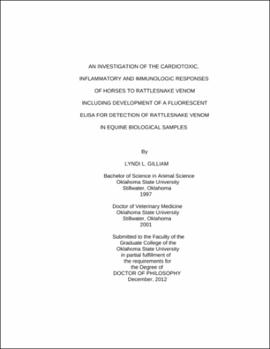| dc.contributor.advisor | Ownby, Charlotte L. | |
| dc.contributor.author | Gilliam, Lyndi Liane | |
| dc.date.accessioned | 2013-11-26T08:35:14Z | |
| dc.date.available | 2013-11-26T08:35:14Z | |
| dc.date.issued | 2012-12 | |
| dc.identifier.uri | https://hdl.handle.net/11244/7660 | |
| dc.description.abstract | Clinical outcomes following rattlesnake bites in horses are widely variable and reasons for this variability are unknown. Being able to quantify venom dose could be helpful in further investigating the effects of rattlesnake venom in the horse. We hypothesized that ELISA techniques could be used to detect venom in equine biological samples. A double sandwich fluorescent ELISA was developed to detect venom in urine and at the bite site of horses with a clinical diagnosis of rattlesnake bite. Venom was successfully detected in equine biological samples using the fluorescent ELISA. | |
| dc.description.abstract | We hypothesized that rattlesnake bitten horses frequently experience cardiac damage. In order to detect both myocardial cell injury and electrical dysfunction, cardiac troponin I (cTnI) and electrocardiography were used to document cardiac damage in naturally envenomated horses. Twenty horses with clinical diagnosis of snake bite were included. Serum and plasma were collected at selected intervals. Holter monitors (Zymed, Philips) were placed at presentation, 1 week and 1 month post presentation. Plasma was assayed for cTnI using a fluorometric assay (Stratus CS, Dade Behring). A significant number of horses had elevated cTnI (p<0.05) at one or more time points. Holter readings were available for 20 horses and revealed arrhythmias or tachycardia in 14 horses. | |
| dc.description.abstract | We further hypothesized that increased TNF- alpha concentration could result in cardiac damage. Serum samples were assayed for TNF- alpha using a commercial assay (Endogen). There was a positive correlation between cTnI and TNF- alpha (p<0.02). We hypothesized that pre-existing anti-venom antibodies would be protective against cardiac damage. Antibody titers to Crotalus atrox were measured at presentation, 1 week and 1 month. None of the horses had pre-existing antibody titers and no correlations were made between cardiac damage and antibody titers. | |
| dc.description.abstract | Finally, we hypothesized that horses would produce anti-venom antibodies when vaccinated with a rattlesnake toxoid vaccine that would be comparable with natural envenomation. Naturally envenomated horses had significantly higher antibody titers than vaccinated horses (p<0.004). | |
| dc.description.abstract | A model of rattlesnake venom induced cardiotoxicity is needed to further investigate the causes and potential treatments of cardiac damage following rattlesnake envenomation. | |
| dc.format | application/pdf | |
| dc.language | en_US | |
| dc.rights | Copyright is held by the author who has granted the Oklahoma State University Library the non-exclusive right to share this material in its institutional repository. Contact Digital Library Services at lib-dls@okstate.edu or 405-744-9161 for the permission policy on the use, reproduction or distribution of this material. | |
| dc.title | Investigation of the cardiotoxic, inflammatory and immunologic responses of horses to rattlesnake venom including development of a fluorescent ELISA for detection of rattlesnake venom in equine biological samples | |
| dc.contributor.committeeMember | McFarlane, Dianne | |
| dc.contributor.committeeMember | Holbrook, Todd C. | |
| dc.contributor.committeeMember | Krehbiel, Clint R. | |
| osu.filename | Gilliam_okstate_0664D_12444 | |
| osu.accesstype | Open Access | |
| dc.type.genre | Dissertation | |
| dc.type.material | Text | |
| dc.subject.keywords | cardiotoxic | |
| dc.subject.keywords | elisa | |
| dc.subject.keywords | horse | |
| dc.subject.keywords | rattlesnake | |
| dc.subject.keywords | venom | |
| thesis.degree.discipline | Veterinary Biomedical Sciences | |
| thesis.degree.grantor | Oklahoma State University | |
